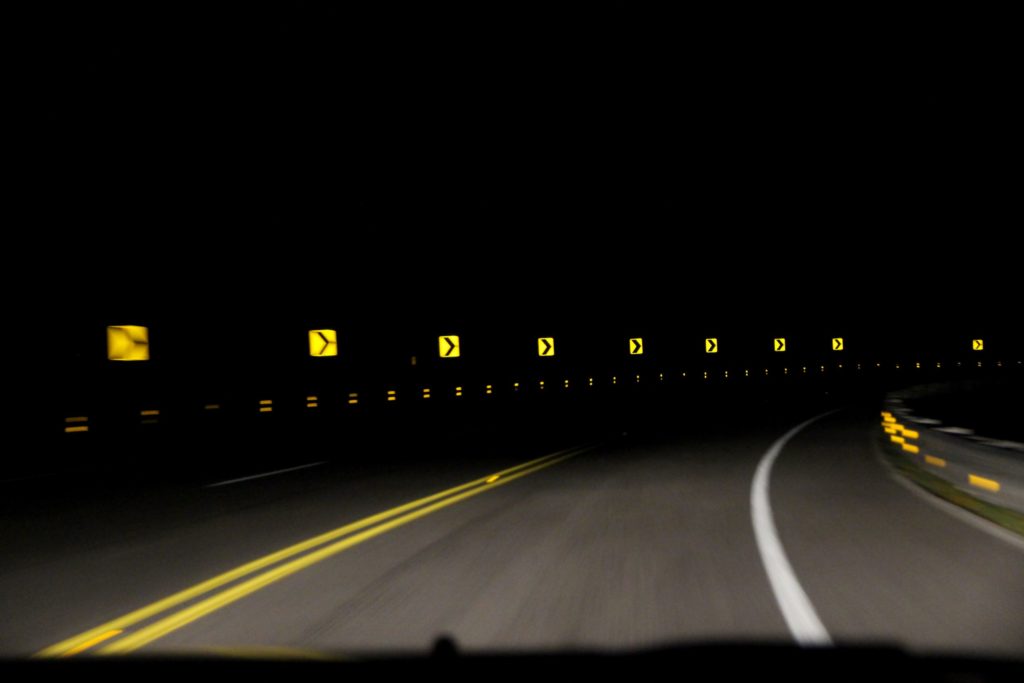An alarming 6,516 pedestrians were killed, and 54,769 pedestrians were injured as a result of traffic crashes in 2020 (NHTSA, 2022). A large majority (77%) of these pedestrian fatalities occurred in low luminance conditions such as nighttime while only 20% occurred in daylight (NHTSA, 2022). This dramatic difference between pedestrian fatalities during the night and day is seen even when controlling for driver fatigue and alcohol consumption (Owens & Sivak, 1996). This phenomenon prompts the question as what is so dangerous about being a pedestrian at night?
There are two problems facing drivers and pedestrians at night that can contribute to pedestrian/vehicle collisions: the degraded visual abilities of drivers and the low contrast of pedestrians. While capable during the day, the human visual system is severely limited at night. Both the visual ability to recognize objects and see fine detail, and the ability to recognize low contrast objects like pedestrians are diminished at night. At night humans experience a loss of color perception and hue as well. However, drivers are typically unaware of the extent to which their visual abilities are reduced at night, as suggested by the selective degradation theory (Leibowitz & Owens, 1977). The theory states that a driver’s ability to detect and recognize roadway hazards degrades with lower illumination, while their ability to steer the vehicle remains unchanged. The unchanged ability of a driver to maneuver a vehicle allows the driver to remain confident in their nighttime driving skills, despite their severely degraded visual capabilities in detecting and recognizing roadway hazards like pedestrians.
Further increasing a driver’s confidence in their ability to successfully detect and recognize hazards at night, much of the visual information drivers rely on to reveal hazards has been designed to be highly reflective or lighted such as streetlamps and taillights. Unaware of their degraded visual abilities, drivers are likely to behave as if their visual systems are unchanged at night—that they can detect and recognize hazards as well as they can during the day. This is demonstrated as drivers typically “overdrive” their headlights at night meaning that people drive at a speed which doesn’t not allow sufficient time to stop the vehicle to avoid a hazard once it is illuminated by the vehicle’s headlights. Thus, once the hazard is illuminated by the vehicle’s headlights, and detected by the driver, a collision could be impossible to avoid.

Many road elements, such as lane markings and signs are designed to be highly reflective at night. However, hazards that do not have retroreflective or active lighting properties often lack sufficient contrast to be visible to nighttime drivers.
In addition to the degraded visual abilities of drivers, the low contrast of pedestrians within a roadway environment is also a significant problem that contributes to pedestrian/vehicle collisions at night. At night, a driver has decreased sensitivity to fine details, color, and contrast, therefore they are less likely to detect and recognize pedestrians. Pedestrians can enhance their visibility to drivers by increasing their contrast through visibility aids such as retroreflective material. Pedestrians can be made more conspicuous to drivers through the proper placement of appropriate visibility aids. Conspicuity differs from visibility such that a conspicuous object is defined as one that ‘grabs’ the observer’s attention with minimal visual search and is easily recognizable. A visible object is defined as an object that simply contrasts with the background. It is vital that a pedestrian be conspicuous to a driver rather than be just visible in order to capture a driver’s visual attention. The more conspicuous the pedestrian, the less likely a collision between the pedestrian and driver. Please see my previous blog titled “The Big Difference Between Conspicuity and Visibility” for more information on the distinction between visibility and conspicuity.
In conclusion, the degraded visual abilities of drivers and the low conspicuity of pedestrians on the road contribute to pedestrian vehicle collisions at night. Drivers are largely unaware of their diminished visual abilities at night and may overdrive their headlights. Pedestrians typically lack sufficient contrast within their environment to be visible to a driver. It is not sufficient to be visible to drivers, but in order to enhance their safety, pedestrians must also be conspicuous to drivers. An awareness of a driver’s degraded visual abilities at night in addition to decreasing vehicle speeds and increasing the conspicuity of pedestrian may help decrease pedestrian/vehicle collisions at night.
Ellen Szubski, Ph.D, CXLT, CPSI, is a human factors consultant at The Warren Group. She earned a Doctorate of Philosophy in Human Factors Psychology and a Master of Science in Applied Psychology from Clemson University. She did her dissertation on “The Influence of Pedestrian Biological Motion on Time-To-Collision Estimates at Night”. She is also a Certified XL Tribometrist and a Certified Playground Safety Inspector. Prior to entering the forensic field, Ellen planned and conducted experiments for a major bicycle manufacturer. She also conducted laser strike perception studies for the Department of Defense. Ellen applies her experience in Human Factors to the analysis of crash investigations and other personal injury matters. These matters often include collisions involving vulnerable road users and drivers, driver distraction, and slips, trips, and falls. She utilizes her knowledge of OSHA regulations, codes, and standards in her analysis of premises liability incidents and safety consulting. Ellen is a current member of the Human Factors and Ergonomics Society (HFES) and it’s Forensic Professional Technical Group.



